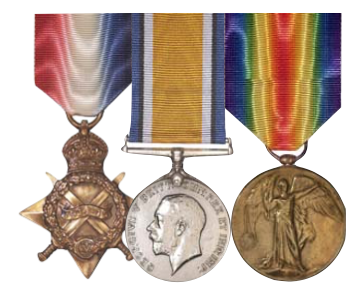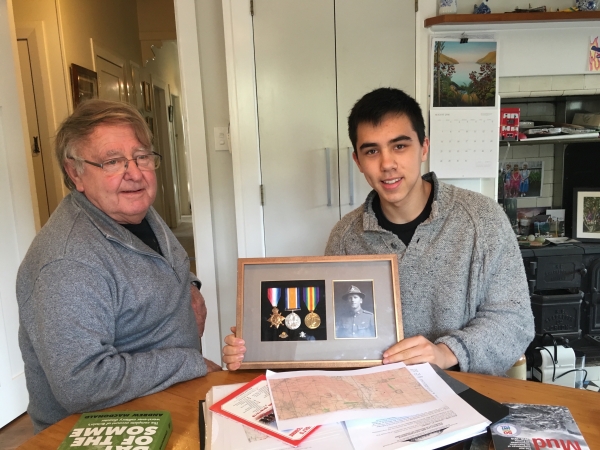I’ve known bits and pieces of my great grandfather’s story but yesterday I had the opportunity to sit down with my grandmother and her brother to uncover the full truth. My great-uncle undertook his own research in France a few years ago, following in the footsteps of his father, including the exact spot where he was wounded, according to field reports. He travelled to many of the places which I too will visit in fewer than two weeks’ time! Here is the story of my great-grandfather which I have put together from anecdotes from our afternoon and reading over the field reports in the weeks preceding his injury on the Western Front. In another blog post, I will upload some photos and scans of a few other interesting bits and pieces I have found. For now, here is "Chun's story".
Chun’s Story
In 1914, within a few days of war breaking out, my great-grandfather William Harold Woodward, known affectionately as “Chun” or “Gannops” by his family, set off with the Samoan Expeditionary Force to capture German Samoa. Having been requested by the British, the aim was to destroy the radio tower which facilitated communication between the German fleet throughout the Pacific. The departure must have been hasty, as his mother spent the night sewing clothing labels onto her son’s uniform, ready for the embarkation the following day. For Chun, a struggling solicitor, it was an opportunity to take a breather from a difficult marriage, and no doubt he hoped that “absence would make the heart grow fonder”.
They arrived in Samoa to find that the radio tower had already been sabotaged and the Germans had for the most part retreated, leaving only civilians of the 14 year-old German colony behind. Two of the largest German warships of the time sat in Apia Harbour with their guns pointed at the city, but they too were quick to leave. Samoa was probably considered too small and insignificant on which to waste artillery! While most of the soldiers were sent back to New Zealand for redeployment in another theatre of war, Chun stayed on in a civil role as Crown Prosecutor, his legal background allowing him to fill one of a number of positions of governance that had been left vacant after the departure of the German administration. He spent a happy and carefree two years in this role engaging with the Samoan and German communities, but it was the death of his two best friends at the Battle of the Somme that provided the impetus to return to New Zealand and travel on to the fighting in Europe.
Chun was back in New Zealand by the end of 1916 and enlisted as a volunteer on the 24th of April 1917. By the time of his second enrolment for general service, he was 29 years old. In June he was stationed at the Trentham Training Camp in Wellington before sailing to France in late 1917 as a machine gunner for the Auckland Machine Gun Corps, itself a division of the Auckland Company. Little is known about the period between his arrival in France and the few weeks preceding his injury near Solesmes, although it can be assumed that he was involved in the various battles of Northern France from early 1918 onwards. Field records show the Auckland Company was billeted at Le Grand Pont in mid October, and on the 18th of October, the company advanced through Esnes, Longsart and Fontaine au Pire onto Beauvois. They were again billeted at Beauvois and spent the next few days around this area, supporting and relieving other battalions. On the 24th of October, the order was given to advance to the town of Solesmes. Chun was stationed in a machine gun nest on the eastern outskirts of the town, and it was here on the 24th of October 1918 in a French field that he was injured and subsequently must have been taken to a field hospital. Conflicting medical reports either suggest a gunshot wound or shrapnel injury, with both reports also stating that he was gassed. It is likely that if he had remained uninjured, he would have formed part of the advancing New Zealand force which liberated Le Quesnoy, a fortified stronghold fewer than ten kilometres to the east. Fighting stopped on the 4th of November 1918 with the Armistice following on the 11th, mere weeks after Chun was brought down on the field.
He was hospitalised on the 13th of November 1918 at the First Southern General Hospital in Birmingham and was later moved to the New Zealand Convalescent Hospital in Hornchurch, Hampstead in January of 1919. On the 10th of February he was discharged and would have had time to explore England and Ireland at leisure before returning to New Zealand on the Ruahine on the 18th of June 1919. He finally arrived back in Wellington on the 11th of July 1919. The 1914—1915 Star was awarded to servicemen and servicewomen who served between 5th August and 31st December 1915 in any “theatre of war”. This would have been awarded to Chun for his service during the capture of German Samoa on the 29th of August 1914. He also received the British War Medal, which recognises the successful conclusion of the First World War (1914–1918) and The Victory Medal, issued to all New Zealand troops serving overseas.
 L-R: 1914-1915 Star, British War Medal, The Victory Medal.
L-R: 1914-1915 Star, British War Medal, The Victory Medal.
His late entry into the European theatre of war meant he had missed the worst of the horrendous slaughters that occurred in the Somme campaign and at Paschendale; these names have remained indelibly stamped on the histories of both our nation and the wider world. Nonetheless, his wounds trapped him in ill-health until his death, necessitating a highly-modified diet which cut out alcohol altogether. In his later age, he would celebrate ANZAC Day by joining other returned servicemen at the local RSA, where he would provide the barman with a bottle of whiskey-coloured water, hiding the inability to drink alcohol, a legacy of the wounds he had received in 1918.
On his return in 1919, he was offered the post of Crown Solicitor of Western Samoa, a mandate of New Zealand from the end of the First World War. Within a day or two of him leaving to begin a new life in Samoa, he met and fell for a young woman whose family was known to his family. His ship was delayed by a strike for three days, enabling the young couple to get engaged to be married. Six months later, she followed him to Samoa. They married and the rest is history. During the near two-decades of his time in Samoa, he rose up the ladder to become fa’amasino sili, or Chief Justice of Western Samoa, and his first three children, including my grandmother, were born in Samoa.
Having only just finished law school and leaving behind a wife and two young children, Chun would have found himself having to take on new responsibilities in a role for which he had little experience in a foreign country with a very different culture. It would have been easy to wait out the war in the relative comfort which Samoa afforded, and no doubt he came to love the country; indeed, he was engaged in useful work during this initial posting. But, the death of his two best friends in the Somme campaign hammered home the tragic reality of war, and subsequently he responded to his conscience by making the incredibly gutsy decision to put himself on the firing line in the European theatre of war. He made a brave and courageous moral choice to respond to a higher call for his service, and ultimately he would pay for this selfless act not only at the time but for the rest of his life. That’s why I will wear his medals and follow in his footsteps with pride.
Thomas Swinburn

Thomas Swinburn
Dilworth
Auckland
Latest from Thomas Swinburn
Related items
Media
Search
Who's Online?
The following members are online:
Latest Forum Posts
- No posts to display.
Powered by Technologywise / Design by yojodesign

